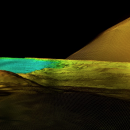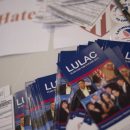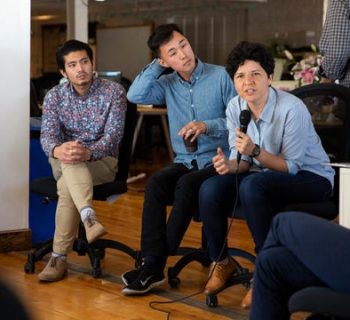By Ryan Kost ~ San Francisco Chronicle ~ January 30, 2018

René Yañez has just spent a good 15 minutes meticulously sorting through scraps of paper in his apartment, filing the bits he likes away into a black folder and mixing up white glue with some water. “Takes a little bit of preparation,” he says before pulling on a padded vest and setting out for Valencia Street.
It’s a short walk to his destination: a wall plastered with political art, all curling at the sides where the glue has stopped holding it down, layers upon layers shouting slogans. Yañez, an elder of the Bay Area Chicano arts movement, finds a place for one of his posters, a critique of cultural eviction in the Mission, applies some glue to the wall and then smooths the poster over, wiping away the stray drops with his bare hand.
He hums to himself as he empties the folder, people passing and hardly noticing as he works. And just like that, he’ll have changed the city — anonymously — even if just in the slightest of ways.
In a sense, this is what Yañez has been doing in the Bay Area since he moved here in the late ’60s. A certain group of people knows him well — they know that he co-founded Galería de la Raza, one of the Mission’s most important cultural institutions; that he is responsible for much of the way the Mission celebrates Dia de los Muertos; that he introduced the Bay Area to Frida Kahlo with an exhibition of her work and ephemera; that he’s helped so many artists the ink would run dry in your pen if you tried to make a list. Those people call him Mission royalty — the Padrino of the Mission.

But those people aren’t most people — most people walk through a neighborhood and a city and a history that he helped shape without ever realizing it or ever knowing his name. As Maria Jenson, the executive director of SOMArts Cultural Center, put it, “He’s like a drop of ink in a napkin that has spread in every direction possible.”
Yañez has an ease about him that makes a person immediately comfortable. He’s disarming. When police occasionally stop him in the middle of pasting something on a public wall, he just shrugs and says it’s art, and there’s really no way to argue, so they leave him alone.
In the 1920s, Yañez’s grandfather made photographs. You can still find them with an Internet search. Mostly they were the postcard variety, romantic images of Mexican cities. Yañez’s father, too, made art. He burned images of the Virgin of Guadalupe into wood. This is all to say that art found René Yañez generations before he was ever born.
Yañez’s family emigrated from Tijuana when he was young. He spent most of his childhood in San Diego. As he got older, he planned on art school and fame, the way many young artists do, even if they deny it. But the Vietnam War intervened, and Yañez found himself in the military in North Carolina, assigned to a medical unit, sketching in his down time.
Even though it was a detour in his life plans, it was a formative one. Essential, even. A lieutenant noticed his sketches and persuaded him to work with “shell-shocked” service men — art as therapy to help heal the trauma left by bombs and bullets. He also saw the civil rights movement unfold firsthand, protesters getting beaten up as they sat quietly in front of department stores. “There was so much hate,” he says. “It affected my being. It politicized me, so when I got back I had a different view on art.”

When his service was over, Yañez made his way to Oakland, just in time for the Human Be-In and the prelude to the 1967 Summer of Love. Almost immediately, he started mixing art and politics. Along with some friends, he started the Mexican American Liberation Art Front. At its heart it was an art collective, but the group was also influential in defining and nurturing a nascent Chicano art scene. “I just felt like we had to create our own symbols, our own iconography,” he says.
He and his friend Ralph Maradiaga, who was the administrative director at the time, operated the Galería differently than most art spaces. Yañez was constantly looking for new and fresh perspectives — opening the space to untested artists who had promise. They crafted a wide definition of what Chicano was for them, pulling in as many coalitions as possible, making sure women and queer people were also included. They invited the public in to critique the art, so that the Mission community had a sense of ownership. And they fashioned new traditions. A simple altar they put up for Dia de los Muertos in 1971 sparked the procession and the many displays that now feel so familiar.
Yañez likes to watch things grow. On a recent overcast afternoon, outside SOMArts, where he works as a curator, Yañez was tending to a garden that has become something of a never-ending art project. Dirt had built up under his nails. “I wanna leave it in good shape,” he says. “I want to leave it behind in a beautiful state.”
It would be near impossible to name all the people whose careers Yañez has helped grow or the collaborators he’s worked with. But certainly a few names are necessary: Culture Clash, Gronk, Guillermo Gómez-Peña, the Royal Chicano Air Force, and even his own son, Rio Yañez, a curator and artist in his own right, with whom he started the Great Tortilla Conspiracy. He helped make room in the Mission for Artists’ Television Access, and has curated shows for SOMArts, the Mexican Museum, the de Young and SFMOMA. He also took it on himself to curate a 1977 retrospective of Kahlo’s work at the Galería — the first of its kind in the Bay Area — after SFMOMA declined his pitch to host a traveling exhibition of her work.
“He’s touched on so many things, and he’s been a part of so many things, and there’s not a lot of documentation to it,” says Rio Yañez, who has worked closely with his father ever since graduating from art school himself. He “was present and facilitated all of these historical things that we take for granted.”

This all amounts to a weighty legacy for a man who speaks softly, and almost never about himself.
The photographer Lou Dematteis remembers Yañez helping him get started in his field. They worked together on a project to document the Mission with photographs at a time the city was cracking down on the lowrider scene. “He was just incredibly inclusive of artists and he was always looking for new artists,” he says.
Even still he’s out there, doing that work. “He’s always going to these places and looking at what people are doing and encouraging them,” says Elaine Katzenberger, the executive director of City Lights Books. She works alongside Yañez in the garden when she can. “He’s an unsung hero in many ways because he’s not out there self promoting.” That’s a sentiment that comes up again and again.
“It’s hard to understand the impact that he’s had because it’s not like he runs around talking about it all the time,” says Renee Baldocchi, who worked with Yañez extensively at the de Young. “He doesn’t spend time trying to pump himself up.”
Yañez has plans for a final show of sorts, an exhibition at the Luggage Store of the work he’s made, a retrospective, set for early March. That he’s only just now getting around to acknowledging his own art doesn’t surprise those close to him. And even as you try to get him to talk about the show, and how it might speak to his legacy, he can’t help but change the subject slightly.
Instead he starts talking again about the Galería or the garden or Kahlo or his son or Dia de los Muertos or all the people who have passed through his life.
“After I’m gone, some things can be left.”
Yañez exhibition
René Yañez’s show at the Luggage Store, 1007 Market St. in S.F., will open March 9 with an opening reception from 6 to 8 p.m. More information: www.luggagestoregallery.org
Source: Ryan Kost is a San Francisco Chronicle staff writer. Email: rkost@sfchronicle.com Twitter: @RyanKost








